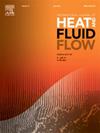Heat transfer mechanism of nucleated bubbles on vertical heating surface induced by 2.4 MHz waves in HFE-7100 liquid
IF 2.6
3区 工程技术
Q2 ENGINEERING, MECHANICAL
International Journal of Heat and Fluid Flow
Pub Date : 2024-10-26
DOI:10.1016/j.ijheatfluidflow.2024.109619
引用次数: 0
Abstract
This research investigates the heat transfer mechanisms of nucleated bubbles on a vertical heating surface using 2.4 MHz ultrasonic waves. The experiments, conducted in a closed rectangular chamber filled with HFE-7100, a hydrofluoroether fluid, varied the surface heat flux from 4.91 kW/m2 to 12.06 kW/m2. The results revealed a notable reduction in temperature on the vertical heating surface due to the influence of 2.4 MHz ultrasound, leading to an average surface temperature decrease of up to 5.3 °C across the entire heat flux range. Analysis of acoustic streaming, flow patterns, and thermally nucleated bubbles using particle image velocimetry (PIV) and a high-speed camera demonstrated the pronounced impact of ultrasonic waves on heat transfer. Our findings highlight the crucial role of 2.4 MHz ultrasonic waves in influencing bubble behavior and enhancing heat transfer on the vertical heating surface. This enhancement is achieved by disturbing the near-wall flow, particularly at lower heat fluxes, with a peak velocity ratio of 5.27 times. This disturbance increases average velocities, indicating potential improvements in heat transfer. Consequently, our study showed a maximum heat transfer enhancement of 83 %. At higher heat fluxes, the interaction with the waves becomes more complex, increasing velocities but limiting streaming coverage in the lower region of the heating surface. The combined effect of 2.4 MHz ultrasound and nucleate boiling convection not only enhances near-wall heat transfer but also amplifies fluid mixing within the chamber. The examination of bubble evolution with and without 2.4 MHz ultrasonic waves underscored the role of acoustic streaming in sweeping bubbles, reducing the size of nucleation sites, and reducing their crowd density, particularly at lower heat fluxes.
2.4 MHz 波诱导 HFE-7100 液体垂直加热面上成核气泡的传热机制
本研究使用 2.4 MHz 超声波研究了垂直加热表面上成核气泡的传热机制。实验在一个充满氢氟醚流体 HFE-7100 的封闭矩形室中进行,表面热通量从 4.91 kW/m2 到 12.06 kW/m2 不等。结果显示,在 2.4 MHz 超声波的影响下,垂直加热表面的温度明显降低,在整个热通量范围内,平均表面温度降低了 5.3 °C。使用粒子图像测速仪(PIV)和高速摄像机对声流、流动模式和热核气泡进行的分析表明,超声波对热传递有明显的影响。我们的研究结果强调了 2.4 MHz 超声波在影响气泡行为和增强垂直加热表面传热方面的关键作用。这种增强是通过扰动近壁流动实现的,尤其是在热通量较低的情况下,峰值速度比为 5.27 倍。这种扰动增加了平均速度,表明传热有可能得到改善。因此,我们的研究结果表明,传热效果最大提高了 83%。在较高的热通量下,与波的相互作用变得更加复杂,速度增加,但限制了加热表面较低区域的流覆盖范围。2.4 MHz 超声波和成核沸腾对流的共同作用不仅增强了近壁传热,还扩大了腔体内的流体混合。在有 2.4 MHz 超声波和没有 2.4 MHz 超声波的情况下,对气泡演化的研究强调了声流在扫除气泡、减小成核点尺寸和降低其拥挤密度方面的作用,尤其是在较低的热通量下。
本文章由计算机程序翻译,如有差异,请以英文原文为准。
求助全文
约1分钟内获得全文
求助全文
来源期刊

International Journal of Heat and Fluid Flow
工程技术-工程:机械
CiteScore
5.00
自引率
7.70%
发文量
131
审稿时长
33 days
期刊介绍:
The International Journal of Heat and Fluid Flow welcomes high-quality original contributions on experimental, computational, and physical aspects of convective heat transfer and fluid dynamics relevant to engineering or the environment, including multiphase and microscale flows.
Papers reporting the application of these disciplines to design and development, with emphasis on new technological fields, are also welcomed. Some of these new fields include microscale electronic and mechanical systems; medical and biological systems; and thermal and flow control in both the internal and external environment.
 求助内容:
求助内容: 应助结果提醒方式:
应助结果提醒方式:


